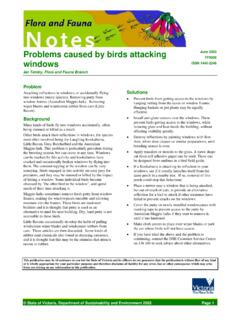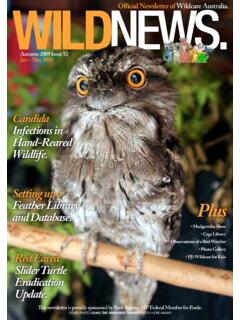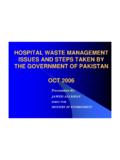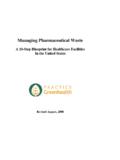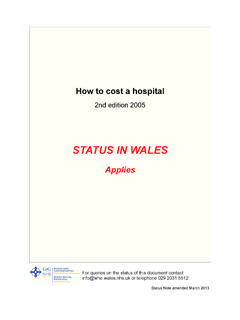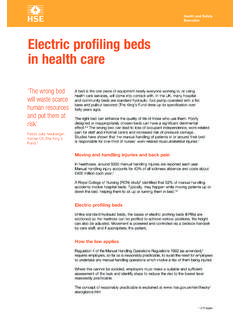Transcription of Easy Reference Sheet - Wildcare Australia
1 As a wildlife rescuer, you will often need to deal with checking and disposing of deceased animals. Below are some general guidelines on some of the most common issues surrounding this topic. How do I know it s dead? It is not uncommon for wildlife to die just after their rescue. Signs that the animal has died include:- Lack of heartbeat - Place your hand over the thoracic (chest) area and feel closely for a heartbeat.
2 This is difficult to do in reptiles. No respiration - Check the thoracic/chest area carefully and monitor for the rise and fall of the lungs. Note that reptiles can hold their breath for a long time or breathe so shallowly you may not notice. The pupils may be widely- dilated. The animal may exhibit agonal breathing just before death (sudden gasping and difficulty breathing). The animal will have no reflexes touch the eye and monitor for blinking or eye movement.
3 The corneal surface of the eyes become glazed and wrinkled. Rigor mortis may have already begun to set in. The length of time that this takes will depend upon the ambient temperature and the size of the animal. If in doubt, take the animal to your nearest vet for confirmation of death. Reptiles are best to be taken to a wildlife vet where they will warm the reptile and check for its heartbeat using a doppler to confirm death.
4 Checking animals found on the road The following guidelines should be adopted by volunteer wildlife rescuers with regards to wildlife found on or close to the road. Do not stop on or near a road to check an animal unless it is absolutely safe to do so. Human safety must always come first. The guidelines set out in the Wildcare Safety Management Manual - Working on Roads must be followed. Ensure that the animal is moved off the road to shoulder.
5 This will prevent an accident occurring if a vehicle hit the carcass (particularly for large animals) and will help prevent unnecessary death of other wildlife that may feed on the carcass. Check that the animal is deceased by checking the steps listed above. Determine the sex of the animal (for mammals) and if female, carefully check the pouch for a joey(s). If no pouch young is found, check the surrounding area for young that may have been thrown from the pouch on impact.
6 You can check the teat to see if the animal was lactating by gently squeezing it and checking if any milk is present. If the pouch is quite small, the teats are not enlarged and there is no milk present then it is less likely that a joey is present). Large animals ( macropods) should be reported to your local Council for collection (see contact details on page 2). Dead koalas should be collected and taken to a wildlife hospital or alternatively reported to the EHP, a Wildcare Koala Coordinator or other wildlife care group in the area.
7 Dead koalas are processed by EHP for the purposes of collecting data. Ensure that you record sightings of dead wildlife in your Wildcare Rescue/Carer Records as road kill sightings. It is important that this data is recorded and collected. easy Reference Sheet Dealing with Deceased Animals easy Reference Sheet Dealing with Deceased Animals (continued) Marking dead wildlife It is suggested that dead wildlife (particularly larger species such as macropods)
8 That are being left on the side of the road for collection by local Council, are clearly marked to indicate that they have been checked to ensure that they are deceased and that there are no live joeys present. This can be done by spraying an X on the rump of the animal, ensuring that it is well visible from the road by motorists. A spray can of line marking paint is suitable for this purpose. Use a bright colour that is easily visible (such as fluorescent orange or green).
9 Try not to avoid red, as this has resulted in motorists reporting the animal as being injured/bleeding. Disposing of dead wildlife All deceased animals should be disposed of in a suitable manner. Appropriate methods of disposing of deceased wildlife include:- Council waste service Most Councils accept small animals being placed in their wheelie- bin service ( birds, small mammals and reptiles). Ensure that they are secured in several plastic bags before placing in bin.
10 If the rubbish service day has just passed, keep the animal frozen until the next service day. Burying animals should be buried to a depth of at least 45cm. Rocks or logs should be placed over the burial site to ensure that domestic or wild dogs or foxes do not dig up the carcass. Refuse Station Most Councils have public refuse stations that specifically cater for the burial of deceased animals. Many of the Councils will allow wildlife rehabilitators to dispose of animals at no cost.


